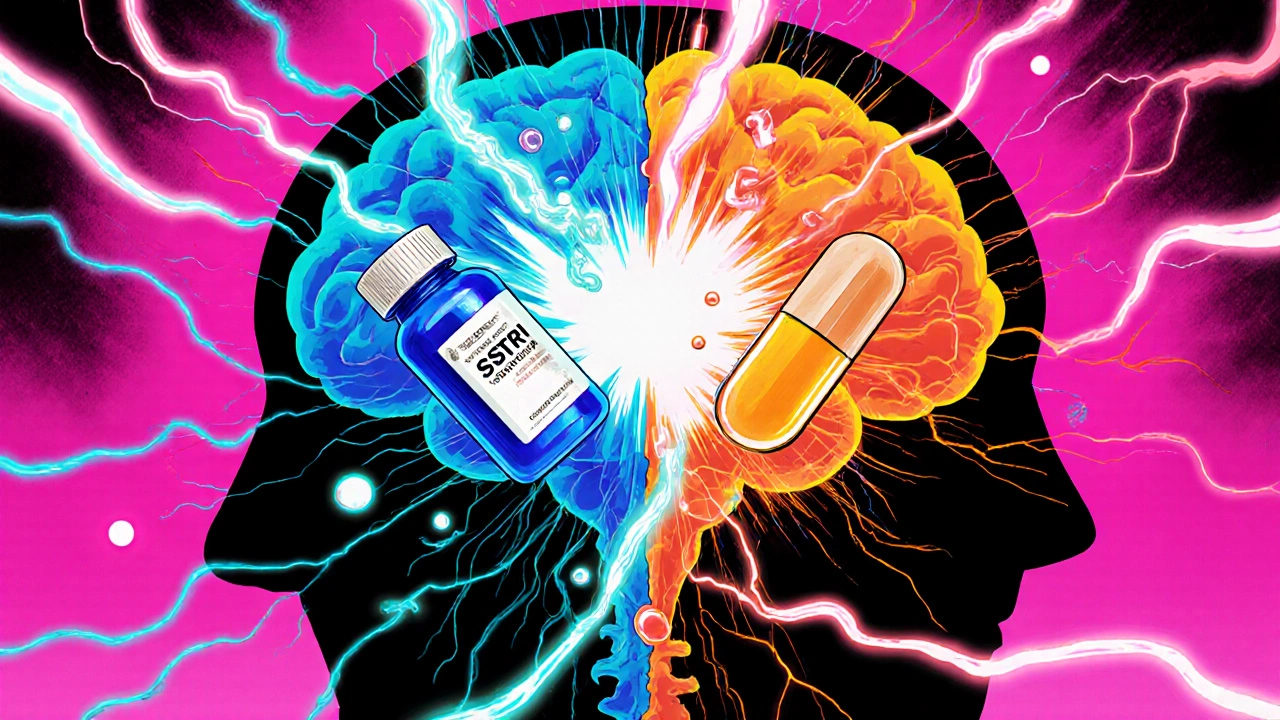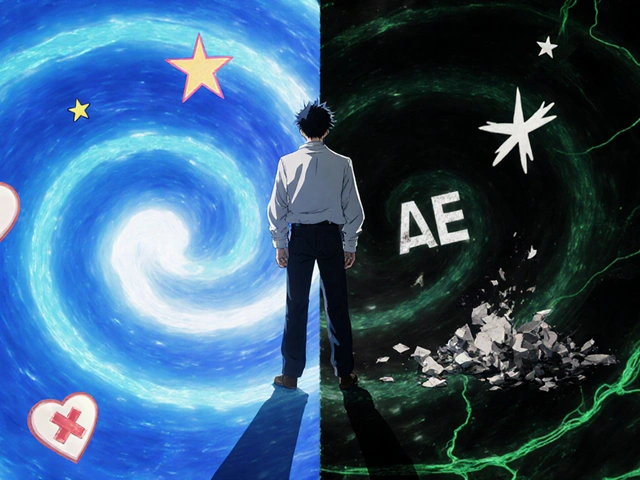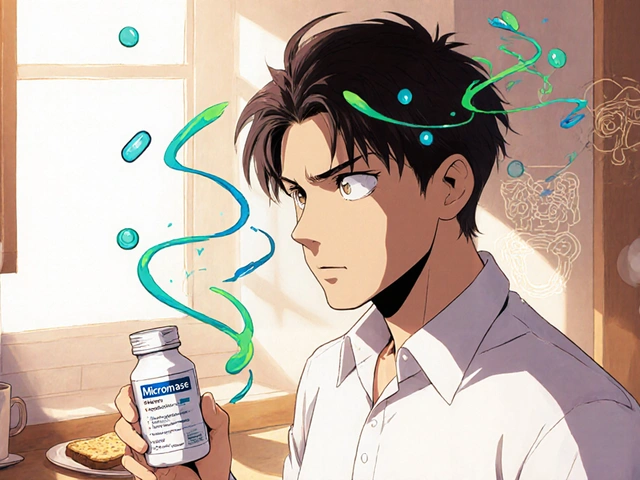Serotonin Syndrome Risk Checker
This tool helps you understand your risk of serotonin syndrome when combining 5-HTP with SSRIs. Always consult with your healthcare provider before adjusting medications or supplements.
Risk Assessment
Based on your inputs, we'll calculate your risk of serotonin syndrome.
Quick Takeaways
- Combining 5-HTP with any SSRI dramatically raises the chance of serotonin syndrome.
- The Hunter Criteria is the most reliable way to spot the condition early.
- Even a low 5-HTP dose (25‑50 mg) can push serotonin past safe limits when an SSRI is on board.
- Stop the combo instantly and seek medical care; cyproheptadine is the antidote of choice.
- Safe practice: wait at least two weeks after stopping an SSRI (longer for drugs like paroxetine) before starting 5-HTP.
What are 5‑HTP and SSRIs?
5‑HTP is a naturally occurring amino acid that sits one step away from serotonin in the brain’s biosynthetic pathway. When taken as a supplement, it bypasses the rate‑limiting enzyme tryptophan hydroxylase and feeds directly into serotonin production. Typical over‑the‑counter doses range from 50 to 300 mg per day.
SSRIs (selective serotonin reuptake inhibitors) are prescription antidepressants that block the serotonin transporter, keeping serotonin hanging around the synapse longer. Common agents include fluoxetine, sertraline, citalopram, and paroxetine.
Both aim to boost serotonin, but they do it from opposite ends: 5‑HTP cranks up production, while SSRIs keep the neurotransmitter from being cleared. When you stack them, serotonin can sky‑rocket.
How serotonin syndrome develops
The brain contains several serotonin receptor subtypes. Excessive stimulation of the 5‑HT2A receptor is the main culprit behind the toxic picture known as serotonin syndrome, a potentially fatal hyper‑serotonergic state. Laboratory studies show serum serotonin levels above 300 ng/mL-well beyond the normal 101‑283 ng/mL range-cause neurotoxicity.
SSRIs halt reuptake, so serotonin stays in the cleft. Add 5‑HTP, and the brain pours out even more serotonin. The result is a "perfect storm" where the feedback mechanisms are overwhelmed, leading to the classic triad of cognitive, autonomic, and somatic disturbances.

Risk numbers you need to know
Single‑agent SSRIs rarely trigger the syndrome (0.08‑0.52 cases per 1,000 person‑years). The moment you add 5‑HTP, the risk jumps into the double‑digit range, comparable to the notorious SSRI‑MAOI combination.
| Combination | Estimated Risk % | Typical Dose Range |
|---|---|---|
| SSRI alone | 0.05 | 20‑60 mg fluoxetine |
| SSRI + 5‑HTP | 12‑16 | 25‑300 mg 5‑HTP |
| SSRI + MAOI | 16.4 | Standard MAOI dose |
| SSRI + Tramadol | 4.6 | 50‑100 mg tramadol |
| SSRI + St. John's Wort | 2.3 | 300‑900 mg extract |
Notice how the 5‑HTP pairing rivals the most dangerous SSRI‑MAOI mix, even though 5‑HTP is sold without a prescription.
Spotting serotonin syndrome early
Three diagnostic frameworks exist, but the Hunter Criteria (97 % sensitivity, 96 % specificity) is the gold standard for emergency physicians. The key findings are:
- Spontaneous clonus
- Inducible clonus plus agitation or diaphoresis
- Hyperreflexia with ocular clonus
- Hyperthermia > 41 °C (106 °F) in severe cases
Mild cases may present only with tremor, diarrhea, or shivering-easily missed if you’re not looking for them.
What to do if you suspect serotonin syndrome
1. Stop all serotonergic agents immediately. That means both the SSRI and the 5‑HTP supplement.
2. Call emergency services if you see any of the following: hyperthermia, rigid muscles, seizures, or rapid heart rate.
3. In the ER, clinicians often give cyproheptadine (4‑8 mg orally, repeat every 2 hours as needed) to block the excess serotonin. Supportive care includes IV fluids, cooling measures, and monitoring creatine kinase levels (CK > 1,000 U/L signals muscle breakdown).
4. Discharge plans usually involve a 2‑week washout before any serotonergic supplement is reconsidered.

Safe practices and recommendations
The consensus from the Mayo Clinic, the American Psychiatric Association, and the American College of Medical Toxicology is clear: avoid the combo altogether.
If a patient truly wants the mood‑boosting effects of 5‑HTP, follow these steps:
- Discontinue the SSRI and allow a washout period. For short‑acting agents like fluoxetine, two weeks is often enough; for long‑half‑life drugs such as paroxetine, wait three to four weeks.
- Re‑evaluate depression severity with a clinician. Sometimes a lower dose of the SSRI or a different class (e.g., bupropion) can replace the need for 5‑HTP.
- If 5‑HTP is still desired, start at the lowest possible dose (25 mg) under strict medical supervision, and monitor serum serotonin if labs are available.
- Educate the patient to watch for any clonus, fever, or sudden agitation, and to seek care immediately.
Remember that over‑the‑counter supplements are not subject to the same safety testing as prescription drugs. ConsumerLab.com found 31 % of 5‑HTP products contain more than the labeled amount, increasing unpredictability.
Frequently Asked Questions
Can I take a low dose of 5‑HTP with my SSRI?
Even low doses can add enough serotonin to push you into the dangerous zone when an SSRI is already blocking reuptake. The safest route is to avoid the mixture entirely.
How long does serotonin syndrome last?
Mild cases often resolve within 24‑72 hours after stopping the offending agents. Severe cases may require hospitalization for several days, especially if complications like rhabdomyolysis develop.
Is the risk the same for all SSRIs?
Risk varies slightly with half‑life and potency. Long‑acting SSRIs (e.g., fluoxetine) linger longer, so the danger window extends. However, any SSRI combined with 5‑HTP raises risk markedly.
What is the best antidote for serotonin syndrome?
Cyproheptadine, an antihistamine with strong 5‑HT2A antagonism, is the preferred pharmacologic treatment. Doses start at 4 mg orally and can be repeated every 2 hours.
Are there any safe serotonin‑boosting supplements?
Most over‑the‑counter options (5‑HTP, tryptophan, St. John's Wort) carry interaction risk when paired with prescription serotonergics. Discuss any supplement with your prescriber before starting.
Bottom line
Mixing 5‑HTP with any SSRI is a high‑risk move that can trigger serotonin syndrome-a condition that can be lethal if not caught early. The safest approach is a clean break between the two, thorough patient education, and vigilant monitoring if a clinician ever deems a combined trial necessary.






